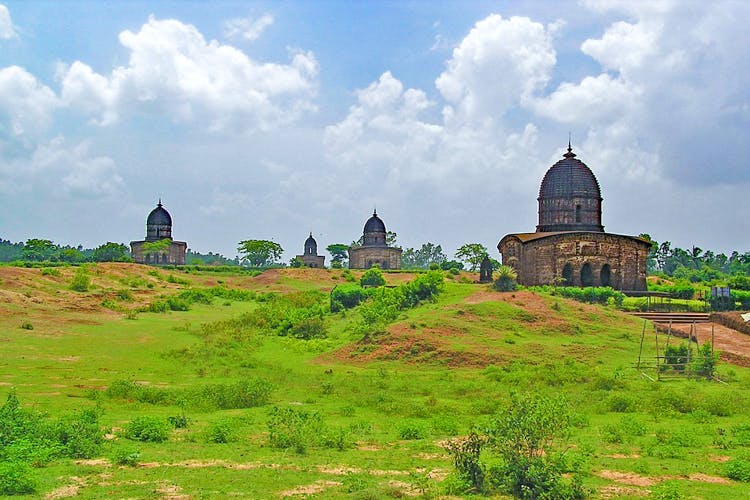Sarees that tell stories, 2D structures that borrow from different architectural styles, and a canon that was used to drive away the Maratha invaders, Bishnupur is a microcosm of Bengal’s past.
A 4-Hour Drive Will Take You To These Terracotta Marvels Of Bishnupur
Shortcut
What Is It?
Bishnupur is a town famous for unique terracotta temples dating back to the 17th and 18th centuries. Made under the rule of Vaishnavite Malla kings, the temples used the local laterite soil to create detailed terracotta work with a distinct look that cannot be found anywhere else.
Why Should I Go?
Because, as we said, the architecture style and the materials, motifs are all one-of-a-kind. The intricate carvings on the terracotta plates of temples and the stuccos show graceful dancers, myths, and motifs from surrounding natural elements. Nearly all temples have carvings depicting the life of Krishna.
They are also an example of Bengal’s unique secular and cross-cultural heritage – the curved roofs which give them a very 2D look from some angles, the arches, moulded brickwork – they are a blend of Bengali, Islamic, and Oriya architecture. The dominant architectural style is the Bengali Eka-Ratna, with a single tower set upon a sloping roof and a square cell, with a porch on each site.
One of the most popular is the Jor Bangla temple with the signature curved double roof of Bengal and its walls covered with intricately carved terracotta plaques. The terracotta work depicts scenes from the Ramayana and Mahabharata. Another interesting structure in the 16th century Raas Mancha which is almost pyramidal in shape.
How Do I Get There?
You can drive down – it takes four hours via Bankura, Beliator, Sonamukhi, Khandaghosh on SH 2.
You can also take any of the direct trains from Kolkata such as the Hwh Prr Exp {12827}, Rupasibangla Exp {12883}, amd Aranyak Express {12885}.
Anything Else?
Don’t leave without seeing the 12.5ft Dalmadal cannon was fired in 1742 when the the ‘Bargis’ – Maratha armies – had attacked Bishnupur!
Bishnupur also does a series of well-known Bengal handicrafts like the patachitra {painted scrolls}, Dashavatara cards which used to be an ancient card game {individual cards are now collector’s items}, terracotta toys {especially the long-eared Bankura horse which is also the symbol of the Central Cottage Industries in India}.
The town is also known for Baluchari sarees – rich and regal silks with mythological tales woven into them. The weavers who draw inspiration from the temple motifs. Traditionally, beige tussar silk is used as a base, with designs woven in maroons, reds, deep purple, and gold – giving the sarees a very royal touch. The sarees are hard to find as the weavers who make them are taking up other jobs. You can buy these in the town as well as in some shops in Kolkata {try this outlet}.

